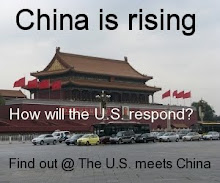by Rizwan Ladha, Nuclear Policy Wonk, and author of Reconsidering it All
After many arduous months of tough negotiations between the US and Russian teams, Presidents Obama and Medvedev have finally agreed to a new follow-on treaty to the 1991 Strategic Arms Reduction Treaty I (START I), which formally expired in December 2009. The fact sheet is available here. And, noting this is very a propos,exactly one year and three days after Obama's 2009 speech in Prague, Obama and Medvedev will meet in that same city to formally sign the "New START Treaty".
This is all well and good, and given the delicate interests of both parties and the tenacity of the negotiating teams, the results are satisfactory. But are the agreed-upon cuts really substantial enough? Let's take a look at the numbers:
- 1,550 warheads, including those on deployed ICBMs (intercontinental ballistic missiles) and SLBMs (submarine-launched ballistic missiles). This is a 74% reduction from 1991 levels.
- A combined limit of 800 deployed and non-deployed ICBM launchers, SLBM launchers, and heavy bombers equipped for nuclear armaments.
- A separate limit of 700 deployed ICBMs, deployed SLBMs, and deployed heavy bombers equipped for nuclear armaments.
Second, and more importantly, let's look at that first big number: 1,550 warheads each. EACH. Sure, it's a good start, and certainly a significant cut from 1991 levels. But in this writer's humble opinion, over 3,000 nuclear weapons between the US and Russia is still way too many. Here's why:
In December 2006,scientists who worked with Carl Sagan in the 1980s on the "nuclear winter" theory took a hypothetical (though realistic) scenario in which India and Pakistan, engaged in a limited regional nuclear war, detonated a total of 100 Hiroshima-sized nuclear weapons on the South Asian subcontinent.
The results of their analysis showed that while immediate fatalities would hover around the 20 million mark, the radiation, soot and debris resulting from the nuclear exchange would create a global cooling effect, affect rainfall levels, destroy agricultural crops and yield at least one billion deaths worldwide from starvation alone. A good synopsis of this study, with links to more detailed information, can be found here.
These are the results from just 100 nuclear weapons being exploded, each at Hiroshima-size levels. The US and Russia are now agreeing to a combined number of warheads that is more than 30 times that (and don't forget that both countries'strategic warheads have destructive powers 10 to 30 times that of Hiroshima's "Little Boy"). If even one nuclear warhead was used on a city in Russia or the US, the resulting nuclear exchange (justified under the basic sovereign right to self-defense) would be unfathomably devastating.
If you ask me, these cuts aren't good enough. Moreover, as Julian Borger at the Guardian says, "the real question now is whether both sides have the stamina to carry on cutting arsenals." The NPT Review Conference is coming up in May, and this writer is privileged to be a delegate to the event. Undoubtedly, the international community, particularly non-nuclear weapons states and activist groups, will be looking to Russia and the US to continue the momentum and make additional deep cuts as they pave the road towards Global Zero.
The White House is calling this the "New START Treaty." If you ask me, that just isn't encouraging enough.
Rizwan Ladha is a master's degree candidate at the Fletcher School of Law and Diplomacy at Tufts University, where he is focusing on nuclear security issues and the role of the US in advancing the global nonproliferation and disarmament agendas. He also serves as the Online Communications Coordinator for the International Physicians for the Prevention of Nuclear War (IPPNW), a non-partisan global federation of concerned citizens who share the common goal of creating a more peaceful and secure world freed from the threat of nuclear annihilation.
Share This! (the gift that keeps on giving)
Latest Analysis
D&D Contributors
The D&D Vault
-
▼
2010
(168)
- 10/17 - 10/24 (2)
- 10/10 - 10/17 (1)
- 09/26 - 10/03 (2)
- 09/19 - 09/26 (2)
- 09/12 - 09/19 (1)
- 08/29 - 09/05 (1)
- 08/22 - 08/29 (2)
- 08/08 - 08/15 (1)
- 08/01 - 08/08 (1)
- 07/25 - 08/01 (2)
- 07/18 - 07/25 (3)
- 07/11 - 07/18 (2)
- 07/04 - 07/11 (5)
- 06/27 - 07/04 (2)
- 06/20 - 06/27 (9)
- 06/13 - 06/20 (3)
- 06/06 - 06/13 (1)
- 05/30 - 06/06 (3)
- 05/23 - 05/30 (1)
- 05/16 - 05/23 (1)
- 05/09 - 05/16 (2)
- 05/02 - 05/09 (2)
- 04/25 - 05/02 (4)
- 04/18 - 04/25 (6)
- 04/11 - 04/18 (8)
- 04/04 - 04/11 (8)
- 03/28 - 04/04 (9)
- 03/21 - 03/28 (5)
- 03/14 - 03/21 (2)
- 03/07 - 03/14 (5)
- 02/28 - 03/07 (8)
- 02/21 - 02/28 (8)
- 02/14 - 02/21 (10)
- 02/07 - 02/14 (13)
- 01/31 - 02/07 (8)
- 01/24 - 01/31 (11)
- 01/17 - 01/24 (8)
- 01/10 - 01/17 (6)



.jpg)
0 comments:
Post a Comment